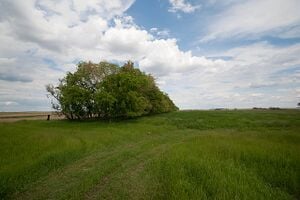
- In North Dakota's Booming Oil Patch, One Tribe Beat Back Fracking, January 21, 2016...[1]
Community energy[edit | edit source]
Wikipedia:
- Solar power in North Dakota on rooftops can provide 19% of all electricity used in North Dakota.
- Wind power in North Dakota: North Dakota is a leading U.S. state in wind power generation, producing 5.53 billion kilowatt-hours or 15.6 percent of all in state generated electricity in 2013
Sustainable transport activism[edit | edit source]
Wikipedia: Hiking trails in North Dakota (category)
About North Dakota[edit | edit source]
North Dakota ( də-KOH-tə) is a landlocked U.S. state in the Upper Midwest, named after the indigenous Dakota Sioux. It is bordered by the Canadian provinces of Saskatchewan and Manitoba to the north and by the U.S. states of Minnesota to the east, South Dakota to the south, and Montana to the west. North Dakota is part of the Great Plains region, characterized by broad prairies, steppe, temperate savanna, badlands, and farmland. North Dakota is the 19th-largest state, but with a population of less than 780,000, it is the fourth-least populous and fourth-most sparsely populated. The state capital is Bismarck while the most populous city is Fargo, which accounts for nearly a fifth of the state's population; both cities are among the fastest-growing in the U.S., although half of all residents live in rural areas.
What is now North Dakota was inhabited for thousands of years by various Native American tribes, including the Mandan, Hidatsa, and Arikara along the Missouri River; the Ojibwe and Cree in the northeast; and several Sioux groups (the Assiniboine, Yankton, Wahpeton, and Teton) across the rest of the state. European explorers and traders first arrived in the early 18th century, mostly in pursuit of lucrative furs.
References